While the rest of the country grapples with soaring incarceration rates and overcrowded prisons, New York City has managed to buck the national trend and slash both its prison population and its crime rate, a recent study published in the Federal Sentencing Reporter found.
Over the last 20 years, the city’s jail and prison incarceration rates declined by 55% while serious crime dropped by 58% – meanwhile, the city’s population jumped by more than one million people.
The reason for those “remarkable” numbers, according to the study, has been a mixture of dramatic cutbacks in policing and prosecuting drug crimes, as well as a concerted effort from grassroots advocates to educate lawmakers and the public about the effects of mass incarceration.
The decline in incarceration rates “flowed from – or at the very least, coincided with – a bottom-up effort to amend, repeal, and reverse the laws, policies, and practices that swept our nation into the era of mass incarceration,” the study said.
Among the policy shifts responsible was an overhaul of the Rockefeller Drug Laws, which implemented harsh mandatory minimum sentences for low-level drug offenses, and the launch of the Drug Treatment Alternative-to-Prison program for drug offenders with at least one prior felony conviction. Prosecutors and judges, too, began relying less on incarceration and probation and opted for more dismissals, adjournments, and fines for drug cases.
There are a few exceptions to the city's decarceration trend, the study notes, including the launch of "broken windows" policing in the 1990s by then-Police Commissioner Bill Bratton. Once the policy took effect, misdemeanor drug arrests rose sharply until 2000, and then again in 2005 under Commissioner Ray Kelly.
Misdemeanor drug arrests began to drop off again in 2011, as drug reform advocates pushed more vocally for less aggressive policing and prosecution of drug crimes.
New York City, the study said, is proof that it's possible for cities to halve incarceration while doubling public safety at the same time.
"The profound decline in incarceration in the nation's largest city ... occurred at a time when New York was also becoming the safest city in America, giving the lie to the notion that dominated criminal justice policy in the United States in the last four decades of the twentieth century that more incarceration was needed to provide more safety," the study said.

